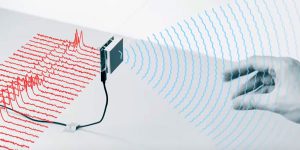 The hand is the most basic input device. It is extremely accurate, fast, and working with it is the most natural thing for a person. Replicating the capabilities of the human hand has become one of the focus areas of Google developers. How can one take these incredible possibilities, the sophistication of human actions and the dexterity of using the hand, and apply to the virtual world?
The hand is the most basic input device. It is extremely accurate, fast, and working with it is the most natural thing for a person. Replicating the capabilities of the human hand has become one of the focus areas of Google developers. How can one take these incredible possibilities, the sophistication of human actions and the dexterity of using the hand, and apply to the virtual world?
The developers used the spectrum of radio frequencies at which the radars work to track a person's hand. Radars are used for a variety of things like tracking cars, large objects, satellites, and airplanes. They used them to analyze microscopic movements, twitching of a human hand. This is needed to interact with wearable devices, the Internet of Things and other computer devices.

The team is currently working on converting the hardware components of the radar into a motion sensor. Radar is a technology that transmits radio waves towards a target. The radar receiver then intercepts the reflected energy from the targets.

The reason we can get so much data from one radar is because of the complete gesture recognition system created by experts. Different aspects of this system are needed to extract certain information about gestures from a single radar signal that we receive at a high frequency. From this strange, alien series of Doppler signals, we can understand a person's intentions.

Radar has some unique properties when compared to cameras. They have very high positioning accuracy, so you can feel tiny movements.
The developers came to this idea of virtual instruments because they realized that there are certain archetypes of controls, like a volume knob or a physical slider. Imagine a button between your thumb and forefinger. The button is not there, but pressing it is a very clear action. There is a real physical tactile response to this action. The hand can simultaneously be a virtual instrument and an instrument for working with this instrument. If this action can be recognized, then an interesting direction in the development of interactive technologies appears.
When Google started this project with their team, they looked at the idea and thought if they could implement it or not. They did not know. But they had to try. Until you try, you won't know.
“What I consider to be the main pride of our project is the expansion of the computing power of electronics to work as sensors” – lead developer of the Soli project.
Radar has a property that other technologies do not have. It can work through different materials. It can be embedded in objects. It allows tracking the accuracy of movements almost perfectly. What's most interesting is the ability to reduce the size of the radar and fit it into a tiny chip. This makes this approach so promising. The reliability is extremely high. There is simply nothing to break here. There are no moving parts. There are no lenses, nothing, just a piece of sand on the board.

The development team is now at the stage where they have the hardware components to sense the interactions and make them work. You can research the quality of their work and how well it will work in products.
It's incredible what things humans are capable of. We hope the developers will be able to create something cool from the world of virtual reality management.
